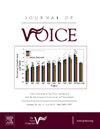Effectiveness of Breath-holding Pulling Exercise in Patients with Vocal Fold Atrophy
IF 2.4
4区 医学
Q1 AUDIOLOGY & SPEECH-LANGUAGE PATHOLOGY
引用次数: 0
Abstract
Objective
In recent years, the incidence of vocal fold atrophy has increased among the elderly. Vocal function exercises (VFE) are performed in patients with age-related vocal fold atrophy; however, treatment could be challenging if the patient is unable to go to the hospital or in hospitals that do not have a speech pathologist. Breath-holding pulling exercises are simple and can be performed anywhere for the management of such patients. This study aimed to examine the effectiveness of breath-holding pulling exercises in patients with vocal fold atrophy.
Study Design
Retrospective study
Methods
With the hands folded in front of the chest, the patients were instructed to take a deep breath, pull their hands to the left and right, and then hold their breath for 5 seconds. The physician instructed the patients to do this 10 times each morning, afternoon, and evening. Speech function, acoustic analysis, pitch range, and Voice Handicap Index-10 (VHI-10) were evaluated and compared before and 4-8 weeks after treatment.
Results
Maximum phonation time (MPT), the primary endpoint, significantly improved after treatment from 14.2 ± 6.6 to 20.3 ± 9.3 seconds. Among the secondary endpoints, mean flow rate (207.5 ± 104.4 to 165.1 ± 66.5 mL/s), pitch range (22.9 ± 8.3 to 26.2 ± 8.1 semitones), VHI-10 (18.1 ± 7.2 to 12.5 ± 6.3 points) jitter (2.5±1.6 to 1.7±1.2%), and shimmer (5.9±3.5 to 4.8±3.3%) showed significant improvement.
Conclusion
Breath-holding pulling exercises were found to be effective in patients with vocal fold atrophy. These can be performed in hospitals with no speech pathologists, in patients who are unable to go to the hospital, and in patients who are hospitalized or unable to speak loudly. Moreover, as with conventional VFE, the training method achieves a high level of patient satisfaction.
憋气牵拉运动对声带萎缩患者的效果
目的:近年来,老年人声带萎缩的发病率有所上升。老年性声带萎缩患者需要进行发声功能锻炼(VFE);然而,如果患者无法去医院或医院没有语言病理学家,治疗就会很困难。憋气牵拉练习非常简单,在任何地方都能进行,可用于此类患者的治疗。本研究旨在探讨憋气牵拉练习对声带萎缩患者的效果:研究设计:回顾性研究 方法:指导患者双手合十放在胸前,深吸一口气,双手向左右拉,然后屏气 5 秒钟。医生指导患者每天上午、下午和晚上各做 10 次。在治疗前和治疗后 4-8 周,对患者的语音功能、声学分析、音域和嗓音障碍指数-10(VHI-10)进行了评估和比较:结果:作为主要终点的最大发音时间(MPT)在治疗后从 14.2±6.6 秒显著提高到 20.3±9.3 秒。在次要终点中,平均流速(207.5 ± 104.4 至 165.1 ± 66.5 毫升/秒)、音域(22.9 ± 8.3 至 26.2 ± 8.1 半音)、VHI-10(18.1 ± 7.2 至 12.5 ± 6.3 分)、抖动(2.5±1.6 至 1.7±1.2%)和颤动(5.9±3.5 至 4.8±3.3%)均有明显改善:结论:憋气牵拉练习对声带萎缩患者有效。在没有语言病理学家的医院、无法去医院的患者、住院或无法大声说话的患者中均可进行。此外,与传统的 VFE 一样,这种训练方法也能获得很高的患者满意度。
本文章由计算机程序翻译,如有差异,请以英文原文为准。
求助全文
约1分钟内获得全文
求助全文
来源期刊

Journal of Voice
医学-耳鼻喉科学
CiteScore
4.00
自引率
13.60%
发文量
395
审稿时长
59 days
期刊介绍:
The Journal of Voice is widely regarded as the world''s premiere journal for voice medicine and research. This peer-reviewed publication is listed in Index Medicus and is indexed by the Institute for Scientific Information. The journal contains articles written by experts throughout the world on all topics in voice sciences, voice medicine and surgery, and speech-language pathologists'' management of voice-related problems. The journal includes clinical articles, clinical research, and laboratory research. Members of the Foundation receive the journal as a benefit of membership.
 求助内容:
求助内容: 应助结果提醒方式:
应助结果提醒方式:


